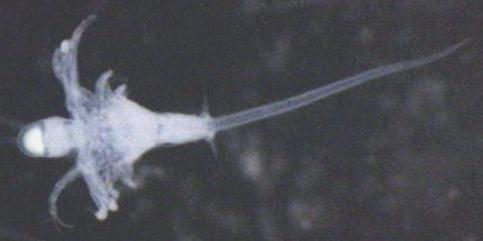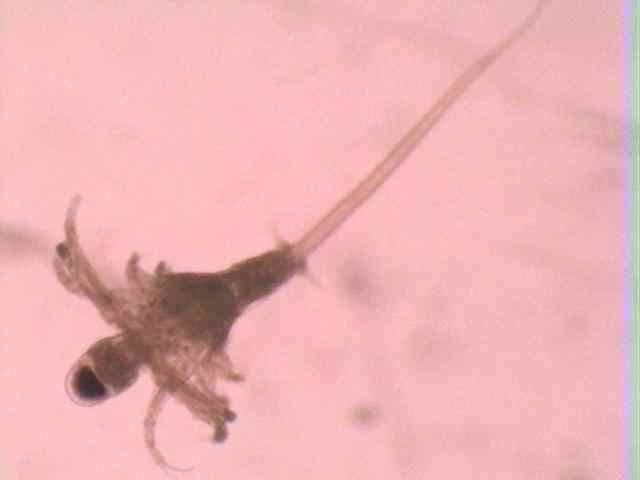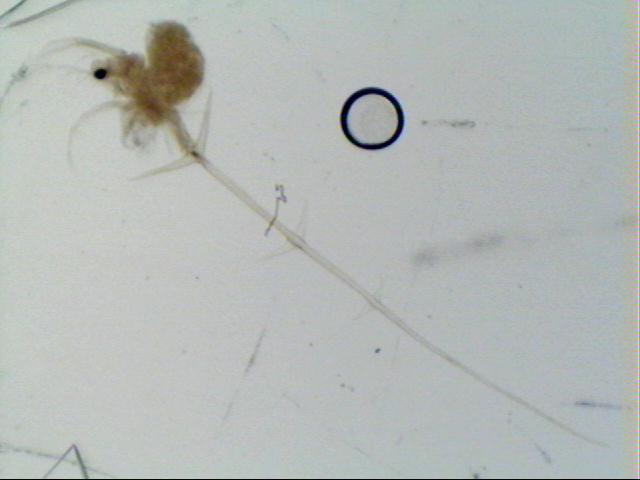|
Classification Kingdom - Animalia Source Bythotrephes cederstroemi invaded the Laurentian Great Lakes in the late 1970's and early 1980's. Lake Michigan was invaded between 1982-1984 (Sprules, 1990). This population of B. cederstroemi is believed to have come from Lake Ladoga, Russia (Sprules, 1990; Berg, 1994; MacIssac, 1999). Anatomy Bythotrephes cederstroemi is a large, unusual cladoceran. Like Polyphemus pediculus, the only part of its body covered by the carapace is the brood pouch. Also like P. pediculus, it possesses one conspicuous compound eye (Sprules,1990; Baker, 1992; Barnhisel, 1995). B. cederstroemi, though, has a long, stout, barbed caudal spine that can comprise up to 80% of the zooplankton's one-centimeter maximum length (Lehman, 1991, Barnhisel, 1995). Distribution Originally found throughout lakes of the Palearctic, B. cederstroemi is now a prominent member of zooplankton assemblages in the Laurentian Great Lakes and other inland lakes of Canada and the United States (Sprules, 1990; Berg, 1994; Barnhisel, 1995). In 1987, densities of 29 m-3 were found in Lake Michigan (Sprules, 1990). Habitat B. cederstroemi inhabits mainly pelagic waters, and is often found in a dense layer above the thermocline in lakes that are stratified (Barnhisel, 1995). All ages are found in upper waters, but juveniles appear to favor deeper waters (Barnhisel, 1995). Feeding Feeding begins within a few hours of birth. In their first 24 hours, B. cederstroemi will eat an average of seven small P. pediculus. Small size, bright colors and weak carapace valves are prey characteristics that are selected for. Polyphemus pediculus, Bosmina, Scapholeberis mucronata, and Ceriodaphnia are all favored prey items (Mordukhai, 1958). If food is not available, B. cederstroemi can live from 1-7 days without food. At higher temperatures, maturation occurs more rapidly, and less food is eaten to reach maturation than at low temperatures (Mordukhai, 1958). Life History Made up almost entirely of females, the population of B. cederstroemi reproduces by cyclical parthenogenesis during summer and fall. In late fall, males are produced, which then contribute to the production of gametogenetic diapausing eggs. With the onset of winter, the adults die, but these diapausing (or resting) eggs are able to overwinter (Sprules, 1990;Yurista, 1997). In 15şC water, it has been found that B. cederstroemi first reproduces at the age of 13 days. It has an average clutch size of 5.1 eggs, which take about 8 days to develop (Sprules, 1990). As the cladoceran ages, it will gain lateral barbs on its caudal spine (up to 3 pairs). Barbs are added during molts and their number is used to identify instars (Barnhisel, 1995). |
Bythotrephes cederstroemi 
Figure 1. The alien-like Bythotrephes cederstroemi is a ferocious predator.  
Figure 2. The barb from B. cederstroemi's caudal spine acts as a defense against predators while it's conspicuous eye often serves to attract them. 
Figure 3. A first instar B. cederstroemi (note it has only one pair of barbs on it's caudal spine). 
Figure 3. A third instar B. cederstroemi (note that this one has three pairs of barbs on it's caudal spine). |
Works Cited Baker, E.A., S.A. Tolentino, and T.S. McComish. 1992. Evidence for yellow perch predation on Bythotrephes cederstroemi in southern Lake Michigan. J. Great Lakes Res. 18(1):190-193. Barnhisel, D.R., and H.A. Harvey. 1995. Size-specific fish avoidance of the spined crustacean Bythotrephes: field support for laboratory predictions. Can. J. Fish. Aquat. Sci. 52:768-775. Berg, D.J., and D.W. Garton. 1994. Genetic differentiation in North American and European populations of the cladoceran Bythotrephes. Limnol. Oceanogr. 39(7):1503-1516. Lehman, J.T. 1991. Causes and consequences of cladoceran dynamics in Lake Michigan: Implications of species invasion by Bythotrephes. J. Great Lakes Res. 17(4):437-445. MacIssac, H.J., and I. Grigorovich. 1999. Ponto-Caspian Invaders in the Great Lakes. J. Great Lakes Res. 25(1):1-2. Mordukhai-Boltovskaia, E.D. 1958. Preliminary notes on the feeding of the carnivorous cladocerans Leptodora kindtii and Bythotrephes. Hydrobiology 828-830. Sprules, W.G., H.P. Riessen, and E.H. Jin. 1990. Dynamics of the Bythotrephes invasion of the St. Lawrence Great Lakes. J. Great Lakes Res. 16(3):346-351. Yurista, P.M. 1997. Bythotrephes cederstroemi diapausing egg distribution and abundance in Lake Michigan and the environmental cues for breaking diapause. J. Great Lakes Res. 23(2):202-209. |
